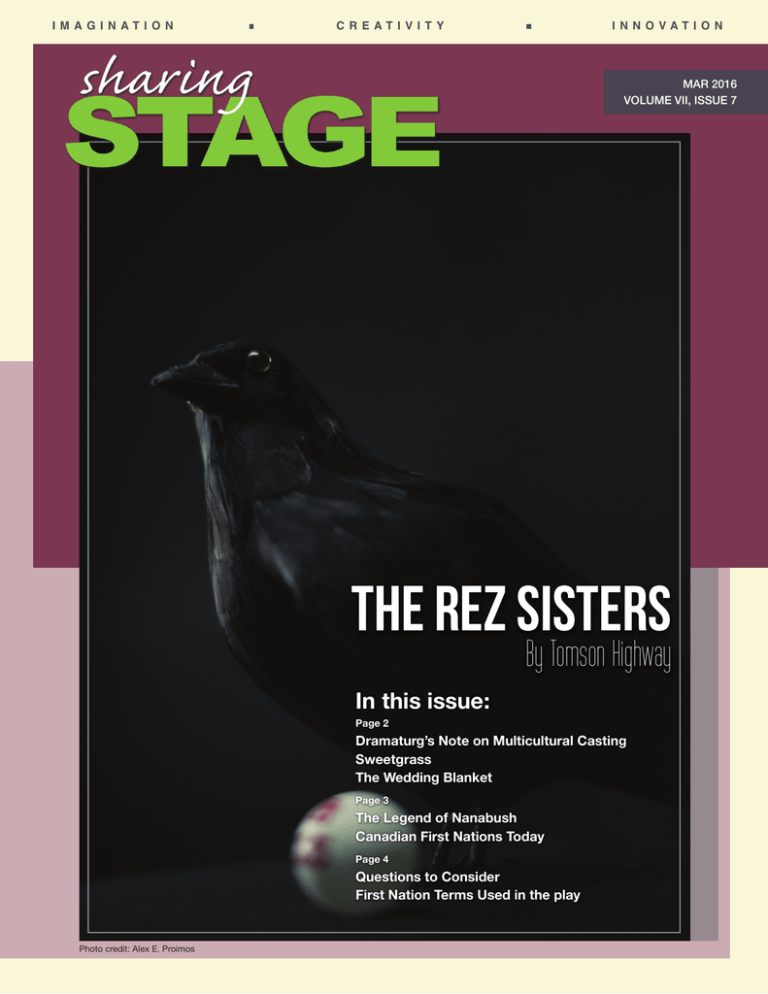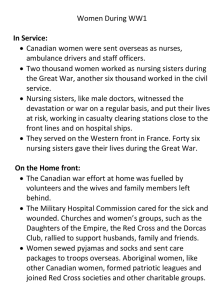the rez sisters - Utah Valley University
advertisement

I MAG I N AT I O N CREAT IVIT Y INNO VAT IO N MAR 2016 VOLUME VII, ISSUE 7 the rez sisters By Tomson Highway In this issue: Page 2 Dramaturg’s Note on Multicultural Casting Sweetgrass The Wedding Blanket Page 3 The Legend of Nanabush Canadian First Nations Today Page 4 Questions to Consider First Nation Terms Used in the play Photo credit: Alex E. Proimos The Rez Sisters: Win A Way Out Dramaturg’s Note on Multicultural Casting Cultural appropriation is a major issue in our society. The genocide of the indigenous people of North America by European settlers took many forms and continued for centuries. So many lives, stories, and traditions were lost over the past several centuries that it’s no light matter when White people use Native American cultures as costumes and decorations or appropriate their mythology and art. This production of The Rez Sisters features a multicultural cast, as did the one mounted in Toronto in 2011. According to the playwright, Tomson Highway, this play is often passed over because of the difficulty in finding a suitable First Nations cast. Dr. D. Terry Petrie, the director of this production, believed that this was a story that needed to be told here and to raise awareness of and start discussions about the topics raised in the play. When the playwright was approached about his play being produced with a colorblind cast in Utah Valley, he thanked the director for choosing the play and wished us luck with the project. It is with the utmost respect that we present this story of how a group of Cree women learn to respect themselves and their home. Kinanâskomitin, we are grateful to you. Sweetgrass Sweetgrass is one of the four sacred medicines of many North American indigenous cultures, along with cedar, sage, and tobacco. Sweetgrass grows to about two feet tall and smells like vanilla. The use of the grass in Native American culture is viewed as an exchange: the grass sacrifices its life to the cleansing smoke in exchange for respectful treatment. It is a sacred element of many Native American cultures, including Cree and Ojibway which are featured in The Rez Sisters. “Sweetgrass is the hair of our Mother; separately, each strand is not as strong as the strands are when braided together.” - Mary Ritchie The Wedding Blanket “The Blanket Ceremony is among the oldest and best loved traditions. Two blue blankets used in the ceremony represent the couple’s past lives that may have been filled with loneliness, weakness, failure, sorrow, and spiritual depression. The couple is wrapped in the blue blankets and their relatives follow them to the sacred fire circle. After the spiritual leader blesses the union the couple, then shed the blue blankets and are enveloped by relatives in a single white blanket representing their new ways of happiness, fulfillment, and peace.” - The Manataka American Indian Council Page 2 The Legend of Nanabush Nanabush is a trickster figure in Native American mythology, as central as Christ is in Christian stories. Nanabush goes by many names and can assume any guise he chooses. In The Rez Sisters, he appears as both a seagull – a spiritual guide who observes and enters into the action of this life -- and a nighthawk – a warning of death and a guide to the spirit world. He is the bridge between this world and the next, a messenger from the Great Spirit, and a teacher of the nature and meaning of existence. According to the playwright, “some say that Nanabush left this continent when the White Man came. We believe he is still here among us – albeit a little worse for wear – having assumed other guises. Without him – and without the spiritual health of this figure – the core of Indian culture would be gone forever.” Canadian First Nations Today Thirty years have passed since the play’s premiere, yet many of the issues remain the same. Since 1980, nearly 1,200 indigenous women were murdered in Canada, at four times the rate of all other Canadian women. 75% of First Nations women are victims of sexual and physical assault. A campaign with Canada’s Amnesty International called No More Stolen Sisters seeks to end the violence faced by First Nations women in Canada. Other issues faced by First Nations citizens include lower income and education rates, higher unemployment and suicide rates, and inadequate housing and healthcare. In recent years, the Canadian government has put more money and effort into their relationship with First Nations Communities, creating social A native dancer looks on during an ‘Idle No More’ gathering on Parliament Hill in Ottawa on Monday, Jan. 28, 2013. Photo by Sean Kilpatrick of The Canadian Press. programs for better education, clean water, and respectful use of natural resources, things they have been criticized for neglecting in the past. Many First Nations people still feel that the government is not doing enough for native communities, but the recent changes in the Canadian Parliament may see an end to these issues. If you would like to learn more about No More Stolen Sisters, or get involved, please visit: www.amnesty.ca/our-work/campaigns/nomore-stolen-sisters Page 3 Questions to Consider • What are the consequences, intentional and unintentional, of western imperialism on native cultures? • What is the significance of the screwdriver in the play? • What is the implication of the image of the Last Supper in the bingo scene? • Do you think the colorblind casting choice was appropriate in this situation? Is it better to produce a culturally specific play with actors whose ethnicities may not match the characters’ than not produce it at all? • Why do you think it’s important to keep cultures and traditions alive? How can you honor your own culture and respect the cultures of others? This map shows the different dialect regions of Cree. The Rez Sisters is set on the island in the Swampy Cree area, Manitoulin Island. First Nation Terms Used in the Play Wasaychigan (Ojibway): window Neee (Cree): Oh, you Awas (Cree): Go away Astam (Cree): Come Anishinaabe (Ojibway): Native people Ojibway song lyrics: “Heaven, heaven, heaven, I’m going there.” CREDITS Sharing Stage is published by the Noorda Theatre Center for Children and Youth at UVU. This issue was guest edited by Ash Knowles under the direction of Dr. John Newman and Dr. Lisa Hall Hagan. WORK CITED: http://www.manataka.org/ http://creemythology.weebly.com/ http://www.ictinc.ca/blog/8-key-issues-for-aboriginal-people-in-canada http://www.amnesty.ca/get-involved/take-action-now/canada-no-more-stolen-sisters https://www.aadnc-aandc.gc.ca/eng/1333037674339/1333037704764 IMAGE CREDITS: Sweet Grass: Norman Criddle, 1906 Nanabush: R.C. Armour, 1905 Map of Cree Dialects: Modified from: Brock University Map Library, Canada, 2004 Manitoulin Island: Old postcard, Murray Dewing, 2006 Page ASL 4 Alphabet Chart courtesy of wpclipart.com, public domain artwork.




